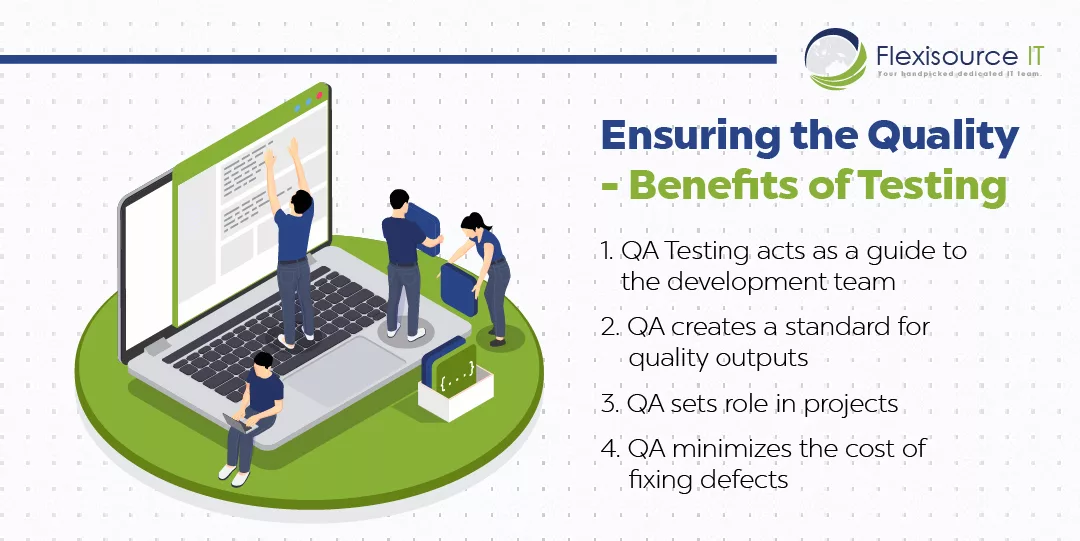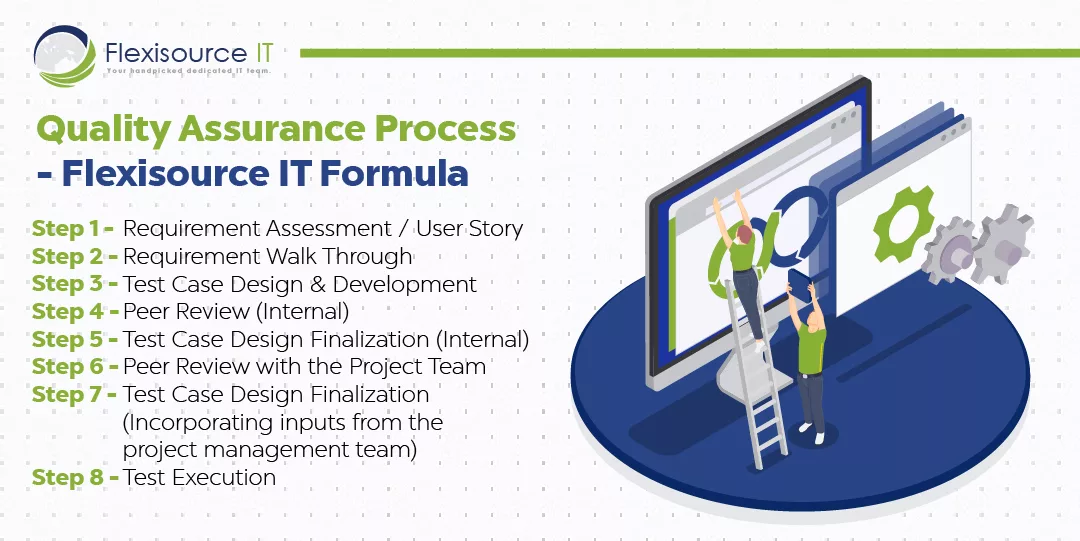Abstract
Many development teams require developers to perform unit testing at a minimum, and some ask them to produce automated, integrated, code-based tests. Still, unit testing or code review only uses coded tests to determine whether a given fix breaks the existing code, the build, or the application’s base functionality and can often bypass defects.
This case study will tackle the significance of Quality Assurance on development in reducing the number of visible customer defects on software or application. This study also features the Flexisource IT Software Testing Life Cycle, formulated by Mr. Niño Adrian Lantican, Flexisrouce IT Project Manager.

Introduction: Quality Assurance in Software Development
Quality Assurance (QA) is an essential aspect of any development project. It is responsible for detecting issues and preventing failures. Having QA in software development aims to provide the highest quality software to the customers and create a compatible product with the requirements.
Automated and Manual Quality Assurance
Automated Testing and Manual Testing have fundamental differences. Automated Testing is when the tester executes the Testing by writing test scripts to perform test automation frameworks and tools for starters.
On the other hand, manual Testing is a meticulous process, whereas the QA Analysts execute tests one-by-one in every test case creation and execution.
However, the most effective testing approaches combine manual and automated testing activities to achieve the best results.
Case Study: Ensuring the Quality – Developer Vs. Quality Assurance Analyst

Case 1: Quality Assurance Testing acts as a guide to the Development Team
Critical Issue:
Developers and testers have different perspectives on delivering a high-quality working product. The main objective of developers is to make the code work based on technical design specifications.
The developer believes that speed in finishing a product is the key to success for businesses. Developer codes having only technical specifications and criteria in mind. As such, Functional requirements are often missed out when coding.
Developer testing usually does not have a process. They focus on the short-term goal or minor issues that they face. They only deploy tools that are convenient to them.
Solution by Flexisource:
Flexisource IT always takes a balanced approach in software development. Speed is necessary, but developers should give time for QA Testing.
Both test engineers and QA need to tackle the defects according to customer workflow or full spectrum.
Since QA Analyst is a document savvy job, it requires many documentations to execute the decision. The QA Analyst should create a tech design or QA process to guide the team to the correct way of handling testing issues, scope creeps, and ambiguity in the requirement.
QA Process will ensure that the team is doing the right thing in the right way as it will be the standard that will bind us all to deliver a high-quality working product.
Case 2: Quality Assurance creates a standard for high-quality Output
Critical Issue:
Developers only conduct unit testing. Unit testing only covers bits and pieces of code that make up an application. Thus, Functional Testing is usually missed out on.
The developer will write the code, test construction base testing, Unit testing, and competent recreation.
Solution by Flexisource IT:
QA will test the system in terms of functionality and end-to-end encryption, depending on the project’s testing objectives that apply to the project.
The QA analysts will then set guidelines, templates and issue the right tools. Usually, QA Testing will create a more extensive list and a longer list of needs in the user story.
In addition, business is actively responding to the needs of business owners. on
Case 3: Quality Assurance sets role in projects
Critical Issue:
Usually, when developing software, application, or website, there are no determining responsibilities among the developers. When an issue arises, it can cause a problem in deciding who is responsible and accountable.
This could create a longer time frame when fixing the issue.
Solution by Flexisource IT:
The QA process should always include the Responsible, Accountable, Consulted, and Informed (RACI) matrix to determine each developer’s responsibility, divide the responsibility, and quickly detect who is accountable.
QA process will also define the roles and responsibilities of each team member to manage expectations of all concerns, including the stakeholders.
The organization will have a responsibility matrix for easy collaboration.
Case 4: Quality Assurance minimizes Relative Cost of Fixing Defects
Critical Issue:
The high cost of software development defects can accumulate when there’s no proper QA process. The cost of a defect can cost 15 times the actual cost. If all features do not have QA Testing, the price will be relatively higher than the budget.
Solution by Flexisource IT:
QA Analysts should keep defect leakage at a minimum. It should be maintained to one (1) per 10 defects.
In this regard, QA helps developers in minimizing defect leakage, boosting confidence in the software.
The Flexisource IT Formula: Quality Assurance Method

Flexisource IT features the QA Process Diagnosis template developed by Mr. Lantican as a guide to review the Software Testing Life Cycle:
1. Requirement Assessment / User Story
This phase is the initial phase of test activities where the requirements are given to the QA Analyst for review. The QA Analyst then will examine the conditions and call out parts that are vague and need improvement.
2 .Requirement Walk Through
This phase is where the BA/Dev/Client sets a meeting to discuss the application and features that need testing.
This meeting should cover topics on the test data and environment. Any concerns from the QA analysts should be laid during the discussion to iron everything out before creating the test case. This part is also where stakeholders explain their requirements for the software.
3. Test Case Design & Development
The software requirements are then translated into test cases by the QA Analyst. The Analyst will clear out the objectives to create the test case that should consist of the scenario, testing techniques, variable conditions, and steps.
The guidelines should be standardized to ensure that quality is based on the set requirements and user-focused. Expected results and actual results also need to be documented during this stage.
4. Peer Review (Internal)
After creating the test cases, the QA Analyst will seek advice from fellow testers or QA Lead to review his work. This will ensure that all issues and clarifications are addressed and filtered out. Afterward, the QA will decide whether it is good to start the test cases finalization.
5. Test Case Design Finalization (Internal)
After the peer review, the QA Lead will reflect all the points and improvements the colleague pointed out to the test case design.
6. Peer Review with the Project Team
QA Specialist will present test case design to the stakeholder for alignment purposes and other project team input the developers have no determining responsibilities,
7. Test Case Design Finalization (Incorporating Inputs from the project management Team)
QA Analyst will finalize the test case design, reflecting all feedback/inputs during the Peer review with the project team.
8. Test Execution
QA executes the test case per scenario on the agreed timeline. QA will then monitor the process to ensure adherence to test standards, policies, and project timeline. QA also needs to document defects and issues.
1. Defect/Issue Management
All discovered defects are recorded timely per failed test case and other process irregularities not related to Testing but impact the software.
2. Test Artifacts Management
Proper documentation on test artifacts generated per test phase is needed to ensure traceability and clarity.
3. Test Reporting
Proper documentation on test progress status and completion report is needed.
Conclusion
To summarize, QA plays a significant role in product and software development. Developers should not underestimate its value.
Having a QA Specialist with the best practices of Quality Assurance ensures that the product complies with the requirement, high standard, and cost will be minimum. QA will not only save time and resources but can also avoid product failure.
In addition, presenting a great QA can convince clients to “Instant buy-in” – one of Mr. Lantican’s crowning glory moments in Flexisource IT.
References
Reichert, A., 2021. Is QA necessary, or should developers do their own testing? www.techbeacon.com/app-dev-testing/qa-necessary-or-should-developers-do-their-own-testing

